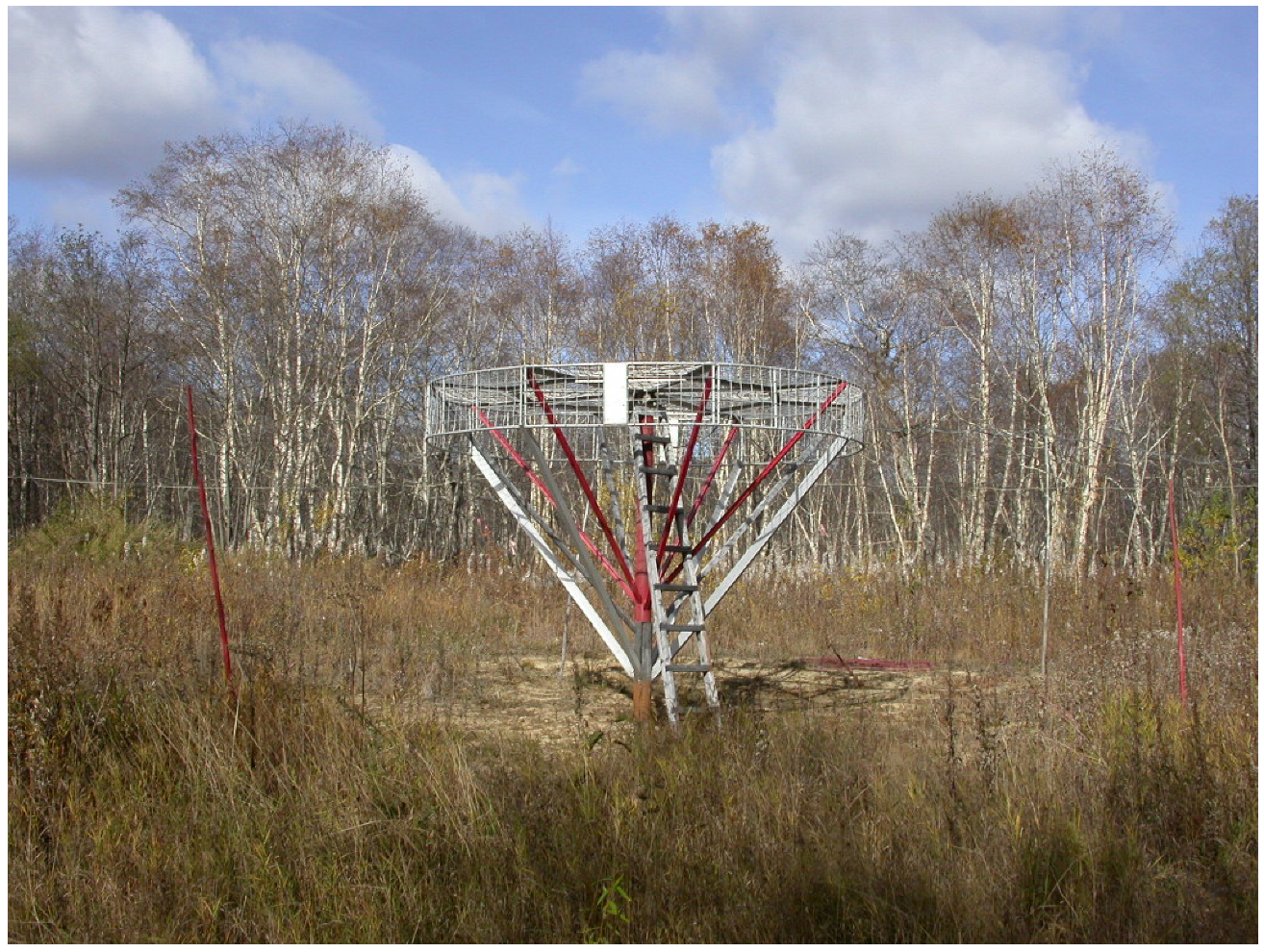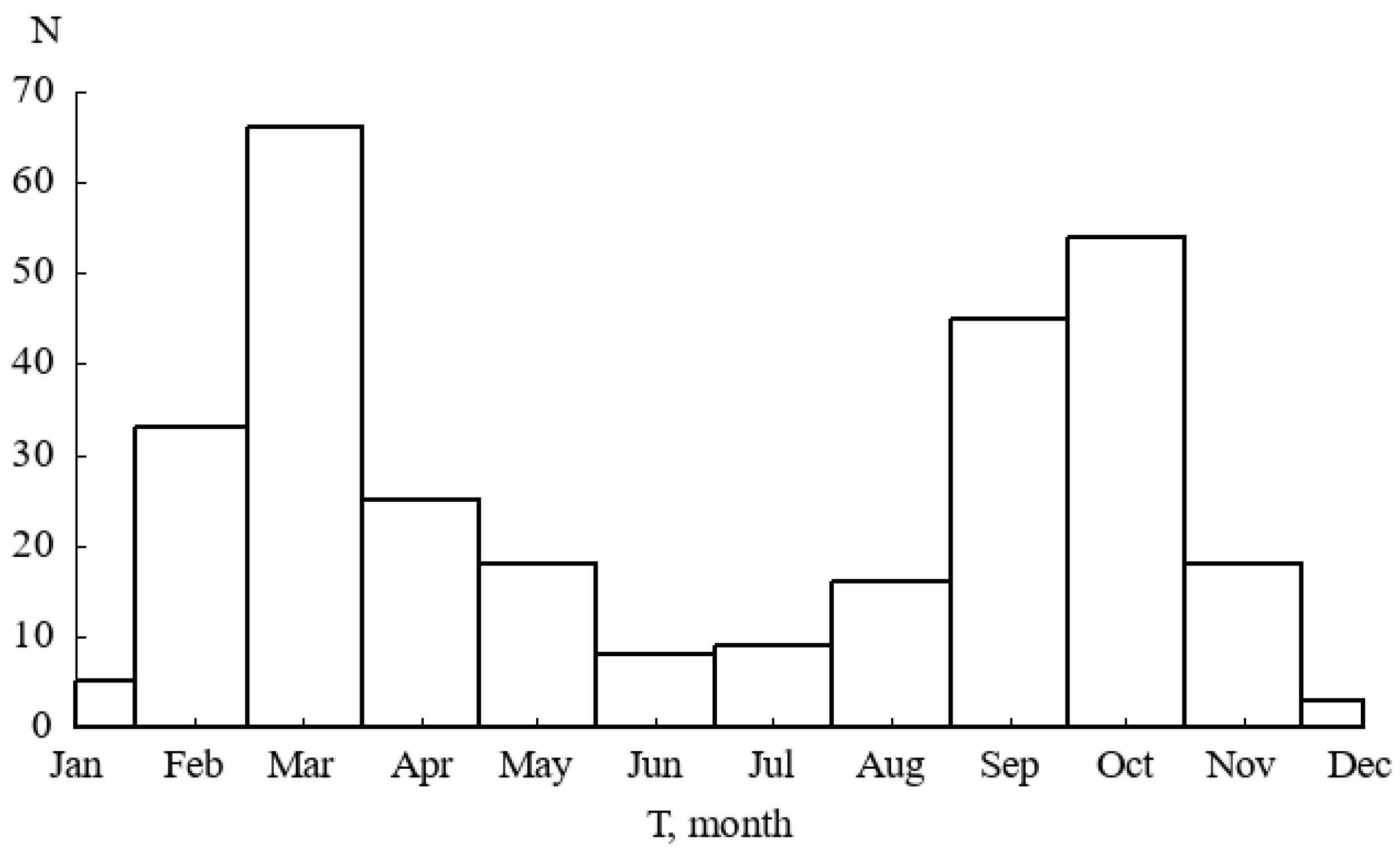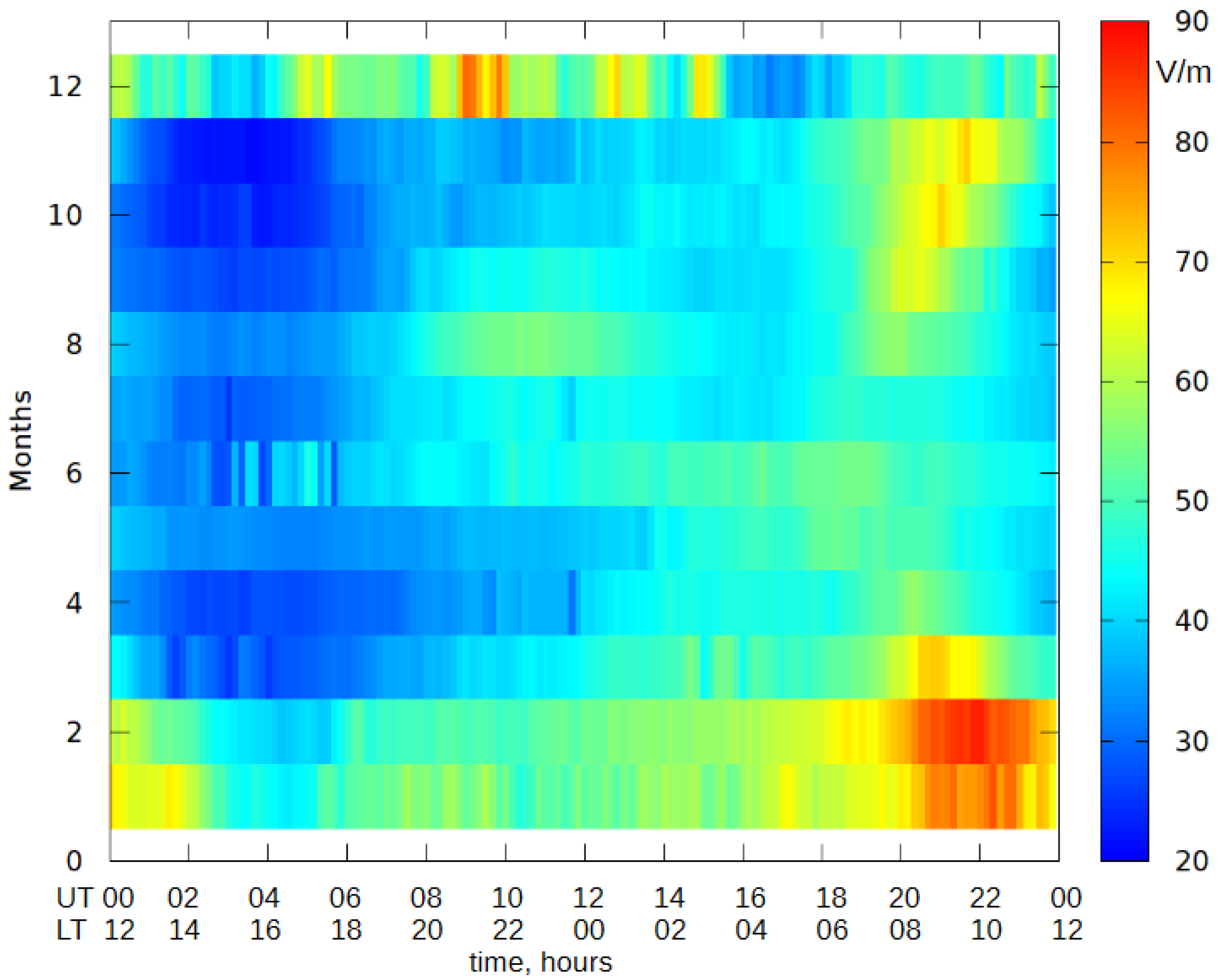Fair Weather and Electric Field Convective Generator
Abstract
1. Introduction
2. History of Determination of Fair Weather
- No negative PG values during a day;
- PG is always less than 1000 V/m during a day.
- No hydrometeors (any water or ice particles that have formed in the atmosphere or at the Earth’s surface as a result of condensation or sublimation);
- No low stratus clouds (cloud base is higher than 300 m);
- Cumuliform clouds in amounts of up to three eighths until they affect the PG record;
- Ground wind average hourly velocity (measured at the height of 10 m) of less than 8 m/s.
- No hydrometeors;
- No low stratus clouds. At most, 3 octas of cumulus clouds or no more than 1 octa when electric effects are clear;
- Wind velocity at a height of 2 m is determined by the following formula: 1 m/s < u2 < 7 m/s.
- (1)
- Wind speed <8 m/s;
- (2)
- Relative humidity ≤80%;
- (3)
- Visibility ≥15 km;
- (4)
- No precipitation;
- (5)
- AEF value between 0 and 1 kV/m;
- (6)
- Geomagnetic activity index .
3. Measurement Instrumentation and Methods at Paratunka Observatory
4. Morning Convective Generator Effect
5. Selecting the Fair Weather Criteria
- Humidity minimum 16–67%;
- Wind 0–12 m/s;
- Air pressure 982.2–1035.9 hPa;
- Solar radiation 352–520 W/m2.
5.1. Precipitation
5.2. Air Humidity
5.3. Fog
5.4. Solar Energy Flux Density
5.5. Wind Velocity
5.6. Air Pressure
5.7. Additional Parameters
- Precipitation 0 mm;
- Maximum wind velocity m/s;
- Air humidity minimum <67%;
- Maximum solar energy flux density >520 W/m2;
- Air humidity of more than 95% for less than 3 h.
- Precipitation 0 mm;
- Maximum wind velocity m/s;
- Air humidity minimum <69%;
- Maximum solar energy flux density >350 W/m2;
- Air humidity of more than 95% for less than 3 h.
6. Application of FW Criteria for Long Data Series Processing
7. Conclusions
- Precipitation 0 mm;
- Maximum wind velocity m/s;
- Air humidity minimum <67%;
- Maximum solar energy flux density >520 W/m2;
- Air humidity of more than 95% for less than 3 h.
- Precipitation 0 mm;
- Maximum wind velocity m/s;
- Air humidity minimum <69%;
- Maximum solar energy flux density >350 W/m2;
- Air humidity of more than 95% for less than 3 h.
Funding
Institutional Review Board Statement
Informed Consent Statement
Data Availability Statement
Conflicts of Interest
Abbreviations
| AEF | Atmospheric electric field |
| FW | Fair weather |
| GEC | Global electric circuit |
| PG | Potential gradient |
| GloCAEM | Global Coordination of Atmospheric Electricity Measurements |
| MCG | Morning convective generator |
References
- Rycroft, M.J.; Israelsson, S.; Price, C. The global atmospheric electric circuit, solar activity and climate change. J. Atmos. Sol.-Terr. Phys. 2000, 62, 1563–1576. [Google Scholar] [CrossRef]
- Rycroft, M.J.; Nicoll, K.A.; Aplin, K.L.; Harrison, R.G. Recent advances in global electric circuit coupling between the space environment and the troposphere. J. Atmos. Sol. Terr. Phys. 2012, 90–91, 198–211. [Google Scholar] [CrossRef]
- Tinsley, B.A. The global atmospheric electric circuit and its effects on cloud microphysics. Rep. Prog. Phys. 2008, 71, 066801. [Google Scholar] [CrossRef]
- Harrison, R.G. The Carnegie Curve. Surv. Geophys. 2013, 34, 209–232. [Google Scholar] [CrossRef]
- Burns, G.B.; Tinsley, B.A.; Frank-Kamenetsky, A.V.; Troshichev, O.A.; French, W.J.R.; Klekociuk, A.R. Monthly diurnal global atmospheric circuit estimates derived from Vostok electric field measurements adjusted for local meteorological and solar wind influences. J. Atmos. Sci. 2012, 69, 2061–2082. [Google Scholar] [CrossRef]
- Jeeva, K.; Gurubaran, S.; Williams, E.R.; Kamra, A.K.; Sinha, A.K.; Guha, A.; Selvaraj, C.; Nair, K.U.; Dhar, A. Anomalous diurnal variation of atmospheric potential gradient and air-Earth current density observed at Maitri, Antarctica. J. Geophys. Res. 2016, 121, 593–12611. [Google Scholar] [CrossRef]
- Harrison, R.G.; Mkrtchyan, H.; Nicoll, K.A. Atmospheric electricity data from Lerwick during 1964 to 1984. Geosci. Data J. 2025, 12, e70009. [Google Scholar] [CrossRef]
- Pawlak, I.; Odzimek, A.; Kepski, D.; Tacza, J. Diurnal, seasonal, and annual variations of the fair-weather atmospheric potential gradient and effects of reduced number concentration of condensation nuclei on potential gradient and air conductivity from long-term atmospheric electricity measurements at Świder, Poland. Ann. Geophys. 2025, 43, 391–416. [Google Scholar]
- Tacza, J.; Raulin, J.-P.; Morales, C.A.; Macotela, E.; Marun, A.; Fernandez, G. Analysis of long-term potential gradient variations measured in the Argentinian Andes. Atmos. Res. 2021, 248, 105200. [Google Scholar] [CrossRef]
- Peng, J.-N.; Fu, S.; Xu, Y.-Y.; Li, G.; Chen, T.; Xu, E.-M. Variations in the Surface Atmospheric Electric Field on the Qinghai–Tibet Plateau: Observations at China’s Gar Station. Atmosphere 2025, 16, 976. [Google Scholar] [CrossRef]
- Gurmani, S.; Ahmad, N.; Tacza, J.; Iqbal, T. First seasonal and annual variations of atmospheric electric field at a subtropical station in Islamabad, Pakistan. J. Atmos. Sol.-Terr. Phys. 2018, 179, 441–449. [Google Scholar] [CrossRef]
- Gurmani, S.; Ahmad, N.; Tacza, J.; Hussain, T.; Shafaq, S.; Iqbal, T. Comparative analysis of local and global atmospheric electric field at the Northern Pakistan. J. Atmos. Sol.-Terr. Phys. 2020, 206, 105326. [Google Scholar] [CrossRef]
- Kundu, S.; Bagiya, M.S.; Gurubaran, S.; Nayak, S.; Hazarika, N.K.; Dimri, A.P. Investigation of Fair Weather Atmospheric Electric Field Variations from the Eastern Himalaya Syntaxis inNorth-East Region of India. Adv. Space Res. 2025, 76, 985–997. [Google Scholar] [CrossRef]
- De, S.; Paul, S.; Barui, S.; Pal, P.; Bandyopadhyay, B.; Kala, D.; Ghosh, A. Studies on the seasonal variation of atmospheric electricity parameters at a tropical station in Kolkata, India. J. Atmos. Sol.-Terr. Phys. 2013, 105, 135–141. [Google Scholar] [CrossRef]
- Yaniv, R.; Yair, Y.; Price, C.; Katz, S. Local and global impacts on the fair-weather electric field in Israel. Atmos. Res. 2016, 172, 119–125. [Google Scholar] [CrossRef]
- Yaniv, R.; Yair, Y.; Price, C.; Reuveni, Y. No Response of Surface-Level Atmospheric Electrical Parameters in Israel to Severe Space Weather Events. Atmosphere 2023, 14, 1649. [Google Scholar] [CrossRef]
- Pustovalov, K.N.; Nagorskiy, P.M.; Oglezneva, M.V.; Smirnov, S.V. Variability of the surface electric field under the influence of meteorological conditions according to observations in Tomsk. Atmos. Ocean Opt. 2024, 37, 815–821. [Google Scholar] [CrossRef]
- Li, R.; Ti, S.; Li, L.; Song, J.; Chen, T. Diurnal variations of atmospheric electric fields on fair weather days and its correlations with aerosols, wind speed, irradiance, and relative humidity. Sci. Rep. 2025, 15, 7030. [Google Scholar] [CrossRef]
- Nichols, E.H. Investigation of Atmospheric Electrical Variations at Sunrise and Sunset. Proc. R. Soc. A. 1916, 92, 401–408. [Google Scholar]
- Kasemir, H.W. Zur Stromungstheorie des Luftelektrischen Feldes III: Der Austaus-Chgenerator. Arch. Meteor. Geophys. Bioclimatol. Ser. A 1956, 9, 357–370. [Google Scholar] [CrossRef]
- Marshall, T.C.; Rust, W.D.; Stolzenburg, M.; Roedes, W.P.; Krehbiel, P.R. A Study of Enhanced Fair-Weather Electric Fields Occurring Soon after Sunrise. J. Geophys. Res. 1999, 104D, 24455–24469. [Google Scholar] [CrossRef]
- Muhleisen, R. The Influence of Water on the Atmospheric Electrical Field. In Recent Advances in Atmospheric Electricity; Pergamon: London, UK, 1958. [Google Scholar]
- Kamra, A.K. Effect of Wind on Diurnal and Seasonal Variations of Atmospheric Electric Field. J. Atmos. Terr. Phys. 1969, 31, 1281–1286. [Google Scholar] [CrossRef]
- Selvam, A.M.; Manohar, G.K.; Khandalgaonkar, S.S.; Ramachandra Murty, A.S.; Ramana Murty, B.V. Diurnal and Seasonal Variations of Space Charge, Electric Field and Cloud Condensation Nuclei in the Lowest Layer of the Atmosphere. Tellus 1980, 32, 232–244. [Google Scholar] [CrossRef]
- Moore, C.B.; Vennegut, B.; Semonin, R.G.; Bullock, J.W.; Bradley, W. Fair-Weather Atmospheric Electric Potential Gradient and Space Charge over Central Illinois, Summer 1960. J. Geophys. Res. 1962, 67, 1061–1071. [Google Scholar] [CrossRef]
- Chalmers, J.A. Atmospheric Electricity, 2nd ed.; Pergamon: London, UK, 1967. [Google Scholar]
- Mkrtchyan, H.; Nicoll, K.A.; Harrison, R.G. Evaluating meteorological reanalysis for identifying fair-weather conditions in historical atmospheric electricity data. Q. J. R. Meteorol. Soc. 2025, e5066. [Google Scholar] [CrossRef]
- Harrison, R.; Nicoll, K. Fair weather criteria for atmospheric electricity measurements. J. Atmos. Sol.-Terr. Phys. 2018, 179, 239–250. [Google Scholar] [CrossRef]
- Harrison, R.G.; Riddick, J.C. Atmospheric Electricity Observations at Lerwick Geophysical Observatory. Hist. Geo- Space Sci. 2022, 13, 133–146. [Google Scholar] [CrossRef]
- Odzimek, A. Personal Communication OYB Observatories’ Year Book, Annual Volumes for 1964. Meteorological Office; HMSO: London, UK, 2018. [Google Scholar]
- Smirnov, S.E. Influence of a convective generator on the diurnal behavior of the electric field strength in the near-Earth atmosphere in Kamchatka. Geomagn. Aeron. 2013, 53, 515–521. [Google Scholar] [CrossRef]
- Nicoll, K.A.; Harrison, R.G.; Barta, V.; Bor, J.; Brugge, R.; Chillingarian, A.; Chum, J.; Georgoulias, A.K.; Guha, A.; Kourtidis, K.; et al. A global atmospheric electricity monitoring network for climate and geophysical research. J. Atmos. Sol.-Terr. Phys. 2019, 184, 18–29. [Google Scholar] [CrossRef]
- Smirnov, S. Atmospheric Electricity Measurements in the Pacific Northwest, Russia. Appl. Sci. 2023, 13, 2571. [Google Scholar] [CrossRef]
- Wind Speed at Height z Above Surface Given Standard Reference Wind Speed Calculator. Available online: https://www.calculatoratoz.com/en/wind-speed-at-height-z-above-the-surface-when-standard-reference-wind-speed-is-known-calculator/Calc-23765#FormulaPanel (accessed on 5 November 2025).
- Smirnov, S. Association of the negative anomalies of the quasistatic electric field in atmosphere with Kamchatka seismicity. Nat. Hazards Earth Syst. Sci. 2008, 8, 745–749. [Google Scholar] [CrossRef]
- Smirnov, S. Reaction of electric and meteorological states of the near-ground atmosphere during a geomagnetic storm on 5 April 2010. Earth Planets Space 2014, 66, 154. [Google Scholar] [CrossRef]







Disclaimer/Publisher’s Note: The statements, opinions and data contained in all publications are solely those of the individual author(s) and contributor(s) and not of MDPI and/or the editor(s). MDPI and/or the editor(s) disclaim responsibility for any injury to people or property resulting from any ideas, methods, instructions or products referred to in the content. |
© 2025 by the author. Licensee MDPI, Basel, Switzerland. This article is an open access article distributed under the terms and conditions of the Creative Commons Attribution (CC BY) license (https://creativecommons.org/licenses/by/4.0/).
Share and Cite
Smirnov, S. Fair Weather and Electric Field Convective Generator. Atmosphere 2025, 16, 1282. https://doi.org/10.3390/atmos16111282
Smirnov S. Fair Weather and Electric Field Convective Generator. Atmosphere. 2025; 16(11):1282. https://doi.org/10.3390/atmos16111282
Chicago/Turabian StyleSmirnov, Sergey. 2025. "Fair Weather and Electric Field Convective Generator" Atmosphere 16, no. 11: 1282. https://doi.org/10.3390/atmos16111282
APA StyleSmirnov, S. (2025). Fair Weather and Electric Field Convective Generator. Atmosphere, 16(11), 1282. https://doi.org/10.3390/atmos16111282





